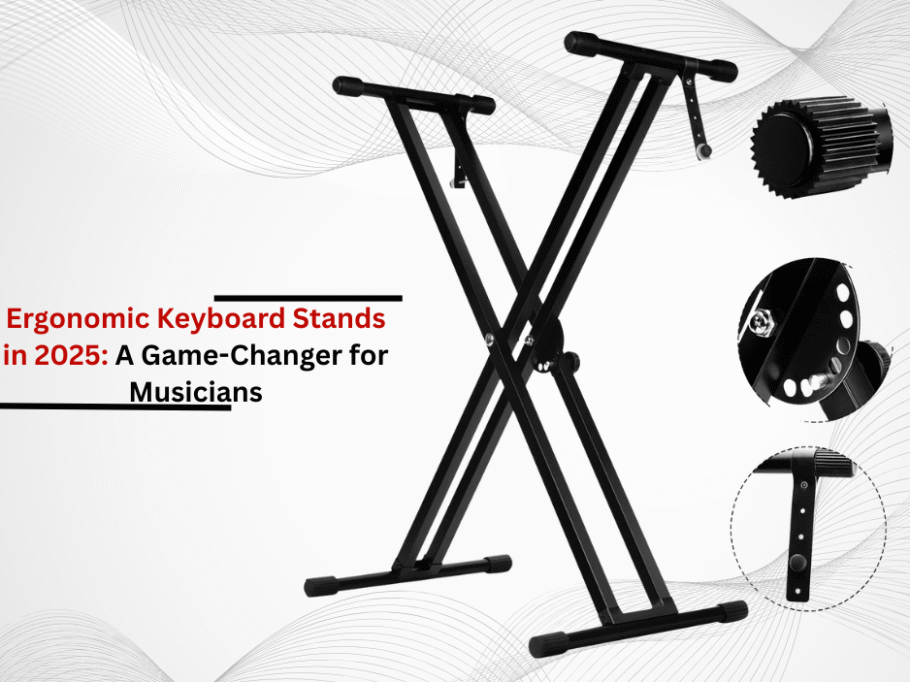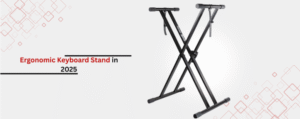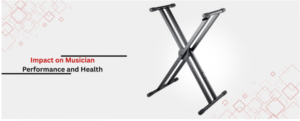Over the past few years, the focus on physical strain concern and performance efficiency has strained the design and function of musical equipment. In 2025, ergonomic keyboard stands are considered essential aids for a musician’s work because of ergonomic requirements such as strain injuries, poor playing posture, and other injuries. These stands are not simply neglectful accessories; they are active solutions designed to improve comfort, flexibility, and creative output. In this blog, I will focus on what changes have occurred towards improving the ergonomic keyboard stands in 2025 from a technological and health perspective, as well as the rationale and philosophy of designs.
To dive deeper, read: How Piano Stands Enhance Your Playing Experience in 2025: A Complete Guide
Ergonomic Keyboard Stand in 2025
The current market is defined by the blending of biotechnical study and smart technologies, leading to the creation of stands that provide the utmost comfort and logical functionality. The product features also entail convenience with sustainability, as manufacturers are adopting the usage of recycled alloys and biodegradable composites. Piano stands are now recognized as the main pillars of contemporary music practice due to their portability and functionality in multi-device ecosystems. As hybrids and mobile setups gain popularity, these feature benefits help meet the most common demands.
Features of Modern Ergonomic Stands
The design of ergonomic keyboard stands in the year 2025 is redefined integration features that focus on better user experiences while combining structural form design and ergonomic function.
Adjustability and Customization:
The older ways of adjusting positions by sitting or standing were replaced with hydraulic and electric height adjust systems, allowing effortless sitting and standing. Moreover, angulation commands enable tilt adjustments of 0° to 35°, catering to different styles of playing. Via companion apps, presets make it possible for performers to configure personalized settings for different spaces or performances.
Material Innovation and Durability:
The adoption of non-slip silicone paddings and shock-absorbent joints increases stability of piano stands even with heavy usage; these are made eco-consciously with recycled polymers that amount to 50% of some models, which directly aligns with global sustainability initiatives. The use of carbon-fiber composites and reinforced aerospace-grade aluminum has resulted in some models that are strong yet portable, constituting up to 50% of some models.
Smart Technology Integration:
Bluetooth allows mobile devices to be synced with non-slip silicone-padded piano stands as they are equipped to lie idly by font so posture feedback could be relayed through embedded sensors that would track movements while. Stacks placed off the bow, alternatively referred to as wireless charging docks and USB-pods, are integrated for higher-tier models, freeing cables from binds and smoothing their concealment. Also, new suggestions put forward include AI-driven ergonomically sound based on usage analytics proposals we’re being presented.
Impact on Musician Performance and Health
There’s an observed correlation between healthier lifestyles alongside increased artistic and muscular output with the adoption of functional stands.
Lowering Physical Stress:
Adjustable settings help avoid unnatural positions that may lead to the development of chronic problems such as lower back pain or carpal tunnel syndrome. The ergonomic placement of the weight helps to ease the stress on the neck and shoulders, which is very useful during extended rehearsals or live calls.
Improving Playability and Imagination:
High and angled keyboard positions lead to optimal mechanical accuracy, especially when executing complex pieces. Lowered discomfort gives more scope for musicians to focus on expressive details and modular add-ons such as secondary tiers for tablets or sheet music help to provide collaboration.
What To Look Out For In 2025
When designing an ergonomic keyboard stand, it is necessary to balance the demands of functionality with practical constraints.
Flexibility and Mobility:
Foldable frames for touring musicians, along with universal mounting systems that are compatible with different-sized and weighted keyboards, guarantee optimal portability. For hybrid setups with laptops and MIDI controllers, multi-tier configurations are recommended.
Long-Term Value and Budget:
Basic entry-level stands under $150 are adjustable, while mid-range keyboard stands priced between $200 to $400 come with smart features and premium materials. Extendable warranties, modular upgrades, and AI-driven ergonomic analytics come at higher-priced options over $500.
Conclusion
In 2025, ergonomic keyboard stands are being developed by 5 Core, Roland, K&M, Gleam, and Chromecast. Each of these brands adds to a market that focuses more on flexibility, sturdiness, and advanced technology. With the ongoing developments in augmented reality, AI, biomaterials, and AI-powered design, the future of piano stands is still unknown. While these brands are at the forefront of redefining ergonomic benchmarks, the workspace requirements along with material sciences technology are evolving at such a speed that even future designs are beyond what one would expect. Moreover, the pace of these changes will outpace all forecasted ergonomic trends. In the end, the future of keyboard stand design will remain open-ended with endless possibilities that could transform the synergy between musicians and instruments.





